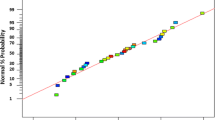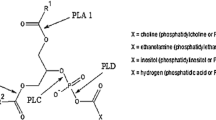Abstract
In present study, phospholipase C (PLC) was applied in camellia oil degumming and the response surface method (RSM) was used to determine the optimum degumming conditions (reaction time, reaction temperature and enzyme dosage) for this enzyme. The optimum conditions for the minimum residual phosphorus content (15.14 mg/kg) and maximum yield of camellia oil (98.2 %) were obtained at reaction temperature 53 ºC, reaction time 2.2 h, PLC dosage 400 mg/kg and pH 5.4. The application of phospholipase A (PLA) - assisted degumming process could further reduce the residual phosphorus content of camellia oil (6.84 mg/kg) to make the oil suitable for physical refining while maintaining the maximal oil yield (98.2 %). These results indicate that PLC degumming process in combination with PLA treatment can be a commercially viable alternative for traditional degumming process. Study on the quality changes of degummed oils showed that the oxidative stability of camellia oil was slightly deceased after the enzymatic treatment, thus more attention should be paid to the oxidative stability in the further application.



Similar content being viewed by others
Abbreviations
- PLC:
-
Phospholipase
- RSM:
-
Response surface method
- PLA:
-
Phospholipase A
- PUFAs:
-
Unsaturated fatty acids
- FFAs:
-
Free fatty acids
- DAG:
-
Diacylglycerols
- NHPs:
-
Non-hydratable phospholipids
- PC:
-
Phosphatidylcholine
- PE:
-
Phosphatidylethanolamine
- PI:
-
Phosphatidylinositol
- PA:
-
Phosphatidic acid
- NPPC:
-
p-nitrophenylphosphorylcholine
- PV:
-
Peroxide value
References
Badan Ribeiro AP, Bei N, Guaraldo Gonçalves LA, Cunha Petrus JC, Viotto LA (2008) The optimisation of soybean oil degumming on a pilot plant scale using a ceramic membrane. J Food Eng 87:514–521
Barton N (2008) A new process for degumming: the use of phospholipase C to improve yields during refining of high phosphorus vegetable oils. In: 99th AOCS Annual Meeting & Expo, Seattle, p 120
Casado V, Martin D, Torres C, Reglero G (2012) Phospholipases in food industry: a review. Methods Mol Biol 861:495–523
Dayton CL, Galhardo F (2008) Enzymatic degumming utilizing a mixture of PLA and PLC phospholipases. US Patents 20080182322A1
Dayton CL, Galhardo FDS, Barton N, Hitchman T, Lyon J, O'donoghue E, Wall MA (2013) Oil degumming methods. US Patent 20130011887A1
De Maria L, Vind J, Oxenbøll K, Svendsen A, Patkar S (2007) Phospholipases and their industrial applications. Appl Microbiol Biotechnol 74:290–300
Dijkstra AJ (2009) Recent developments in edible oil processing. Eur Lipid Sci Technol 111:857–864
Dijkstra AJ (2010) Enzymatic degumming. Eur Lipid Sci Technol 112:1178–1189
Fazel M, Sahari M, Barzegar M (2008) Determination of main tea seed oil antioxidants and their effects on common kilka oil. Int Food Res J 15:209–217
Flieger A, Gong S, Faigle M, Neumeister B (2000) Critical evaluation of p-nitrophenylphosphorylcholine (p-NPPC) as artificial substrate for the detection of phospholipase C. Enzym Microb Technol 26:451–458
Han L, Xu Z, Huang J, Meng Z, Liu Y, Wang X (2011) Enzymatically catalyzed synthesis of low-calorie structured lipid in a solvent-free system: Optimization by response surface methodology. J Agric Food Chem 59:12635–12642
Jahani M, Alizadeh M, Pirozifard M, Qudsevali A (2008) Optimization of enzymatic degumming process for rice bran oil using response surface methodology. LWT - Food Sci Technol 41:1892–1898
Jiang F, Wang J, Kaleem I, Dai D, Zhou X, Li C (2011) Degumming of vegetable oils by a novel phospholipase B from Pseudomonas fluorescens BIT-18. Bioresour Technol 102:8052–8056
Jiang X, Chang M, Wang X, Jin Q, Wang X (2014) Effect of ultrasound treatment on Oil recovery from soybean Gum by using phospholipase C. J Cleane Prod 69:237–242
Kashima M, Cha GS, Isoda Y, Hirano J, Miyazawa T (1991) The antioxidant effects of phospholipids on perilla oil. J Am Oil Chem Soc 68:119–122
Li J, Hu JL, Xie MY, Nie SP, Zhang B (2008) Optimization of degumming process of camellia oil with phospholipase using response surface methodology. Food Sci 29:326–330
Liu Y, Jin Q, Shan L, Liu Y, Shen W, Wang X (2008) The effect of ultrasound on lipase-catalyzed hydrolysis of soy oil in solvent-free system. Ultraso Sonochem 15:402–407
Manjula S, Jose A, Divakar S, Subramanian R (2011) Degumming rice bran oil using phospholipase-A (1). Eur J Lipid Sci Technol 113:658–664
Mei L, Wang L, Li Q, Yu J, Xu X (2013) Comparison of acid degumming and enzymatic degumming process for Silybum marianum seed oil. J Sci Food Agric. doi:10.1002.jsfa.6109
Pan L, Campana A, Toms M (2000) A kinetic study of phospholipid extraction by degumming process in sunflower seed oil. J Am Oil Chem Soc 77:1273–1277
Rajaei A, Barzegar M, Yamini Y (2005) Supercritical fluid extraction of tea seed oil and its comparison with solvent extraction. Eur Food Res Technol 220:401–405
Sahari MA, Ataii D, Hamedi M (2004) Characteristics of tea seed oil in comparison with sunflower and olive oils and its effect as a natural antioxidant. J Am Oil Chem Soc 81:585–588
Smiles A, Kakuda Y, MacDonald BE (1988) Effect of degumming reagents on the recovery and nature of lecithins from crude canola, soybean and sunflower oils. Am Oil Chem Soc 65:1151–1155
Subramanian R, Nakajima M, Yasui A, Nabetani H, Kimura T, Maekawa T (1999) Evaluation of surfactant-aided degumming of vegetable oils by membrane technology. J Am Oil Chem Soc 76:1247–1253
Suliman TE, Meng Z, Li JW, Jiang J, Liu Y (2013) Optimisation of sunflower oil deodorising: balance between oil stability and other quality attributes. Int J Food Sci Technol 48:1822–1827
Xu X, Fomuso LB, Akoh CC (2000) Synthesis of structured triacylglycerols by lipase-catalyzed acidolysis in a packed bed bioreactor. J Agric Food Chem 48:3–10
Yang JG, Wang YH, Yang B, Mainda G, Guo Y (2006) Degumming of vegetable oil by a new microbial lipase. Food Technol Biotechnol 44:101–104
Zhi WG, Tang FL, Huang QT (2010) Enzymatic degumming of camellia oleifera seed oil. China Brewing 224:109–110
Acknowledgement
The work is supported by the Public Welfare Research Funds of State Administration of Grain (201313012–03) and supported by the Major State Basic Research Development Program of China (973 Program, 2012CB720802, 2012CB720806).
Author information
Authors and Affiliations
Corresponding author
Rights and permissions
About this article
Cite this article
Jiang, X., Chang, M., Jin, Q. et al. Optimization of the degumming process for camellia oil by the use of phospholipase C in pilot-scale system. J Food Sci Technol 52, 3634–3644 (2015). https://doi.org/10.1007/s13197-014-1418-3
Revised:
Accepted:
Published:
Issue Date:
DOI: https://doi.org/10.1007/s13197-014-1418-3




